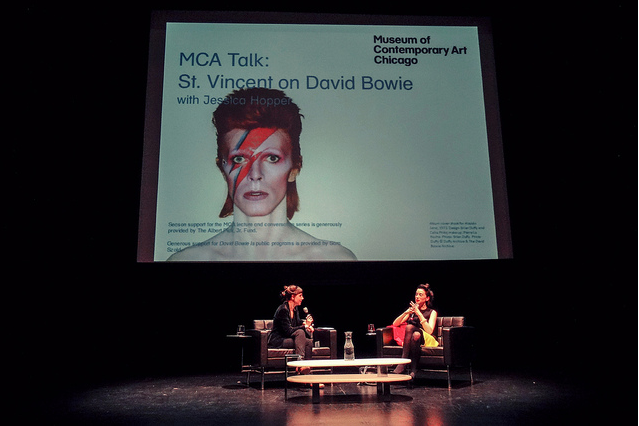St. Vincent Talks Bowie, Authenticity And Aesthetic At The MCA
By Lisa White in Arts & Entertainment on Jan 7, 2015 8:00PM
“If you have the choice, why wouldn’t you insert some make believe?” Fitting words from musical artist St. Vincent as she sat down with Pitchfork Senior Editor and author Jessica Hopper this past weekend to discuss all things David Bowie and art at a sold-out conversation at the Museum of Contemporary Art. The conversation was part of the last few companion performances and events the museum hosted in conjunction with the recently ended David Bowie Is exhibit that set an MCA attendance record. The evening was spent not only discussing Bowie but also talking about authenticity and aesthetic in relation to music and art.
The conversation started with Annie Clark, better known as her moniker St. Vincent, discussing her template of a rock star and reminiscing about her first attempt at looking the part during a gig at a queer bar in Denton, Texas. The ubiquitous rock star getup— wearing leather pants. Which, as first attempts usually do, was a failure thanks to a hideous leather pants-induced camel toe. Even rock stars don’t get it right the first time around.
But one thing good performers do learn and get right over time is a flair for the theatrics. Any rock star worth their weight in gold records knows the importance of dramatics, whether it's an over-the-top lyric meant to push buttons, a guitar slung high above your head during a guitar solo or the towering platforms and stage costumes that made Bowie himself seem otherworldly. Style has always played a huge part in rock 'n' roll. Hopper and Clark hit a nerve for many when they asked the question “when did it become more authentic to stand up on stage with a beard and your feelings?” Hopper pointed out that Bowie, during the start of his career, was dovetailing away from the “feel good” folk vibe that dominated much of the music scene in the late ‘60s. His music, and much of his contemporaries, put a spotlight on the surreal, dazzling fans with a fully realized and thoughtful performance idea. Clark pointed out the notion that visceral has been seen as more authentic by many, at least compared to an artist that chooses to plan out aspects of their show. This isn’t a new argument— the notion that raw, spontaneous talent is somehow more “real” than art that is carefully curated. It all seems a bit silly that these ideas have struggled to coexist in many subcultures since most art is inspired by something, tangible or not, so in a sense everything is a bit derivative in life. Even in pure and original ideas we can find traces of something we experienced or witnessed, even if we aren’t consciously aware of it affecting us. And even if artist don’t like to talk about or admit their original work is still influenced by another person’s art. But when it comes to songs, Clark points out that no matter what, it’s all rooted in music. “We wouldn’t be here if Bowie wasn’t a great songwriter.”
Speaking of Bowie and his songs, Clark shared with the audience some of her favorite Bowie moments including her favorite song from his catalog of work: “It’s No Game (No. 1)” from Bowie’s album Scary Monsters (and Super Creeps). Clark spoke highly of the “menacing” guitar part in the song, courtesy of guitar legend Robert Fripp, a track full of rage and pathos and called it “perfect,” which given her own style of guitar playing and affection for creating music that has a distressing intensity to it, is no surprise.
Clark also spoke about monikers, another common thread she shares with Bowie, and how they provide space in creating your art. Bowie’s own moniker went farther and took on various personas and incarnations to add more distance and space from the artist and his art, and Clark admitted she dipped her own toe into this realm with her latest Digital Witness tour. The tour saw Clark utilize art installation pieces, costuming and choreography, adding more depth to her music and lyrical idea, something Bowie was always fond of as well.
It’s easy to see why the MCA chose St. Vincent to speak during David Bowie Is. She is a fearless songwriter, always examining the slightly unnerving sides of life and society, and has taken the basis of her music and created corresponding art to exist with her narratives, growing even more into her own fully realized production with her latest album and tour. She understands and appreciates when to be subtle and when to be provocative in her art. And much of her fan base has longevity, following her album to album. Those who get her style and sound really invest in her as an artist. All these traits are hallmarks of David Bowie and his career and both his success and St. Vincent’s own rise in popularity show that these factors truly make for a memorable artist. Successful musicians are rooted in great songs, but true and lasting talent is a multifaceted art form that takes a good amount of perseverance and measured thought.
To watch the whole conversation, head over to Stereogum for video from a fan who filmed the evening and posted it online.
